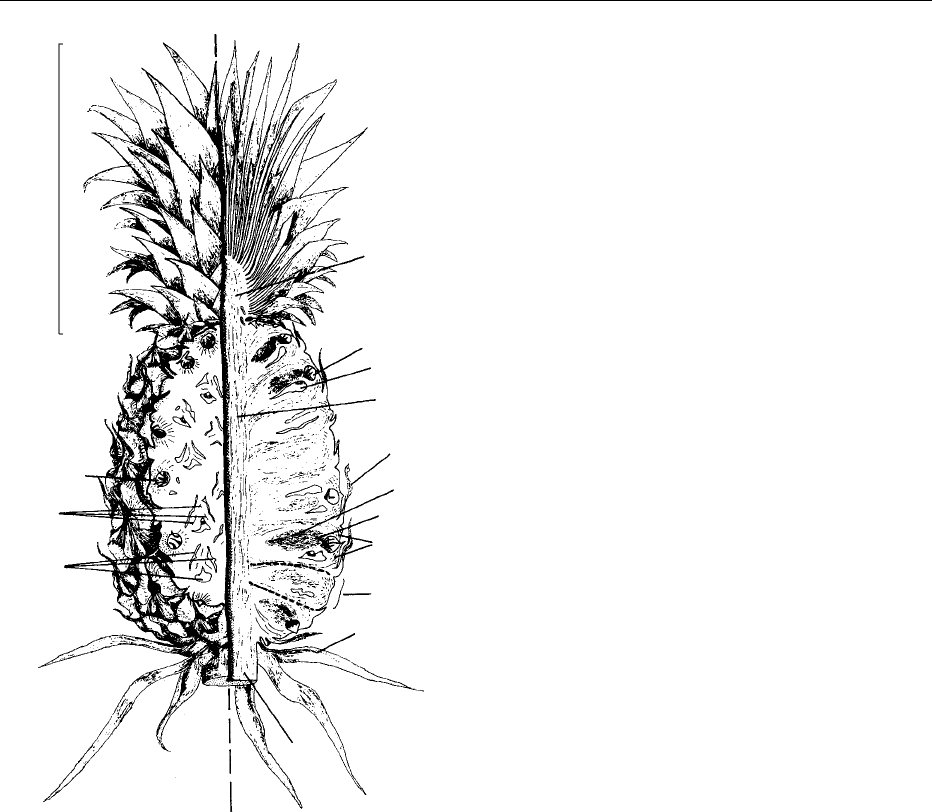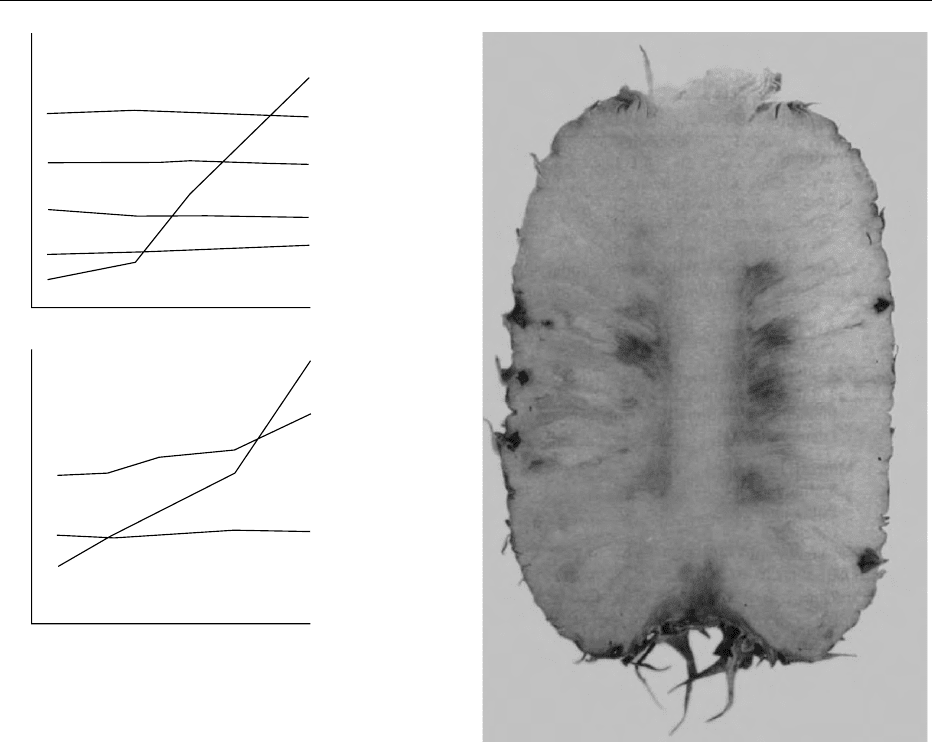Caballero B. (ed.) Encyclopaedia of Food Science, Food Technology and Nutrition. Ten-Volume Set
Подождите немного. Документ загружается.


leaching in water. Salt stock pickles make up the
largest percentage of fermented pickle products.
0019 The controlled fermentation of pickles has been a
goal of the industry for years. In 1973, such a proced-
ure was introduced in the USA. Although the industry
has yet to adopt the entire process, addition of some
of the modifications outlined has improved pickle
quality in general. In particular, most processors
now acidify and purge tanks after brine is added.
Acidification inhibits the growth of acid-sensitive
Gram-positive and Gram-negative bacteria and,
therefore, favors the growth of lactic acid bacteria.
Purging decreases the incidence of bloating, which
results from carbon dioxide production by both the
fermenting microorganisms and the cucumber itself.
0020 Genuine dill These pickles are fermented in 4–5%
sodium chloride, to which dill weed, garlic, and other
spices have been added. It takes approximately 3–6
weeks for fermentation to reach completion, where
the lactic acid content is 1.0–1.5% and the salt con-
tent is 3–3.5%. This type of pickle does not require
desalting, but may be sold as such with the filtered
fermentation liquor. Genuine dill pickles are some-
what susceptible to scum yeast development and
should be consumed within 12 months of
manufacture.
0021 Overnight dill Overnight dill pickles are fermented
in 2–4% sodium chloride, containing dill weed and
garlic, until the desired level of acidity (0.75–1%
titratable acidity as lactic acid) is reached, which
should take approximately 1 week. The product
must then be refrigerated, and should not be kept
longer than 6 months due to its extreme perishability.
Nature of Preservative Action
0022 Two components of the pickling process, acid and
salt, are key participants in the preservation of per-
ishable products. Acid, which may be added directly
or produced through microbial conversion of indi-
genous sugars to acids, will lower the pH of the
product and inhibit spoilage microorganisms. Only
undissociated acid molecules are active in inhibiting
microorganisms; therefore, it is important that the
acidity of pickles be pH 3.5 or below, when most of
the acid present will be in the undissociated form. Salt
also acts to inhibit the growth of undesirable bacteria
and to delay enzymatic softening. (See Acids: Natural
Acids and Acidulants; pH – Principles and Measure-
ment.)
0023 In fermented pickles, microorganisms ferment
sugars to lactic acid and also produce enzymes which
modify pickle texture. The absence of fermentable
carbohydrates is a deterrent to undesirable secondary
fermentations which can be initiated by yeasts at pH
values below 3.8. Residual sugars can also cause gas
production and brine turbidity in finished products if
yeast and bacteria growth continues.
0024Lactic acid bacteria are the primary microorgan-
isms involved in preservation of fermented pickled
products. Although these microorganisms represent
only a smaller proportion of the total microbial flora
present on the surface of plant materials, they pre-
dominate under acidic conditions. In cucumbers,
L. mesenteroides typically grows until the pH begins
to drop, then Pediococcus pentosaceus predominates,
followed by Lactobacillus brevis and finally L. plan-
tarum.(See Lactic Acid Bacteria.)
0025Acidity, salt concentration, temperature, and sani-
tary conditions are the primary environmental factors
which control fermentation. Most vegetables range in
pH from 6.5 to 4.6, while fruits range from 4.5 to 3.0.
In fruits and fruit juices, yeasts and molds predomin-
ate in the more acidic environments. Salt inhibits the
growth of undesirable microorganisms and, in add-
ition, it withdraws water and nutrients from plant
tissues and allows these to become substrates for
lactic acid bacteria.
0026Low temperatures inhibit the growth of lactic acid
bacteria and thus slow fermentation. At 7.5
C, Leu-
conostoc mesenteroides will grow, but the growth of
Lactobacillus and Pediococcus species is very low.
At temperatures in the range 18–23
C, L. brevis
and L. plantarum exhibit active growth while, at
32
C, L. plantarum and P. pentosaceus predominate.
Pasteurization is often the final step in pickle process-
ing. The US Department of Agriculture recommends
that all pickled products should be pasteurized for
safety.
Sensory and Nutritional Attributes
0027Pickling imparts unique characteristics to fruits and
vegetables. Desirable changes in flavor, texture, and
color take place in fermented, pasteurized, and re-
frigerated pickles, and are carefully monitored. How-
ever, some of the same bacteria involved in normal
fermentation, such as the lactic-acid-formers, may
cause spoilage if not destroyed. Selected pickling
problems which may affect sensory quality are listed
in Table 1.
0028Pickled cucumbers are composed primarily of water
(Table 2). They are not a good source of protein or fat,
but are a fairly rich source of vitamin A, vitamin C, and
phosphorus. Salt and sugar additions to the brine will
affect the sodium and carbohydrate contents. (See
Sensory Evaluation: Sensory Characteristics of
Human Foods.) Refer to individual nutrients.
PICKLING 4565

Specific Examples
0029 Pickled cucumbers are by far the most abundant
pickled product available in the western world
today. Other common pickled products include sauer-
kraut, pickled pears, peaches and plums, pickled nuts,
relishes, cured meats, fish and poultry, and specialty
items such as pickled mushrooms and cherries.
0030 Salt stock is used to prepare sour cucumber pickles,
which typically have a final acidity not lower than
2.5%. Sweet pickles are prepared in a similar fashion,
except that a sweet, spiced vinegar solution is added
to the salt stock.
0031 Sauerkraut is produced through salt-controlled
bacterial fermentation. Cabbage selected for sauer-
kraut should have at least 3.5% sugar to insure an
adequate carbohydrate source for bacteria. Shredded
cabbage is mixed with salt (2.25% by weight) and the
final product contains an average of 1.5–2.0% lactic
acid.
See also: Acids: Natural Acids and Acidulants;
Fermented Foods: Beverages from Sorghum and Millet;
Lactic Acid Bacteria; Pasteurization: Principles; pH –
Principles and Measurement; Vinegar; Sensory
Evaluation: Sensory Characteristics of Human Foods
Further Reading
Binsted R, Dewey JD and Dakin JC (1939) Pickle and Sauce
Making. London: Food Trade Press.
Fleming HP (1984) Developments in cucumber fermenta-
tions. Journal of Chemical Technology and Biotechnol-
ogy 34B: 241–252.
Fleming HP and McFeeters RF (1981) Use of microbial
cultures: vegetable products. Food Technology 1: 84–88.
McNair JK (ed.) (1975) All About Pickling. San Francisco:
Ortho Books.
Pederson CS (1930) Floral changes in the fermentation of
sauerkraut. NYSAES Technical Bulletin 168.
Pederson CS (1979) Microbiology of Food Fermentations,
2nd edn. Westport: AVI.
Peterson MS (1977) Pickles. In: Desrosier NW (ed) Elem-
ents of Food Technology, pp. 690–691. Westport: AVI.
Steinkraus KH (1983) Handbook of Indigenous Fermented
Foods. New York: Marcel Dekker.
US Department of Agriculture (1936) Service and Regula-
tory Announcements, no. 2, rev. 5. Washington, DC:
Food and Drug Association.
Pigments See Colorants (Colourants): Properties and Determination of Natural Pigments; Properties and
Determinants of Synthetic Pigments
tbl0002Table 2 Nutritive analysis of pickles: the composition of 100 g of
edible portion (approx. 1 large dill pickle or 1/2 cup of fresh
cucumber pickle slices)
Fermented
dill
pickles
Sweet
pickles
Sour
pickles
Freshpack
cucumber
pickles
Water (%) 93 60.7 94.8 78.7
Food energy (J) 46.2 613.2 42 306.6
Protein (g) 0.7 0.7 0.5 0.9
Fat (g) 0.2 0.4 0.2 0.2
Carbohydrate (g) 2.2 36.5 2.0 17.9
Ash (g) 3.6 1.7 2.5 2.3
Calcium (mg) 26.0 12.0 17.0 32.0
Iron (mg) 1.0 1.2 3.2 1.8
Vitamin A (IU)
a
100 90 100 140
Thiamin Trace Trace Trace Trace
Riboflavin (mg) 0.02 0.02 0.02 0.03
Vitamin C (mg) 6.0 6.0 7.0 9.0
Phosphorus (mg) 21.0 16.0 15.0 27.0
Potassium (mg) 200.0
Sodium (mg) 1428.0 1353.0 673.0
Reproduced from McNair JK (ed.) (1975) All About Pickling. San Francisco:
Ortho Books, with permission. 1 IU ¼ 0.6 mg b-carotene.
Table 1 Selected pickling problems
Problems Cause
Soft, slippery slimy pickles
(discard pickles, spoilage is
occurring)
Hard water
Acid level too low
Cooked too long or at too
high a temperature
Water bath too short,
bacteria not destroyed
Jars not airtight
Jars in too warm a resting
place
Shriveled, tough pickles Pickles overcooked
Syrup too heavy
Too strong a brine or
vinegar solution
Pickles not fresh enough at
outset
Fruit cooked too harshly in
vinegar/sugar mixture
Dark, discolored pickles Iron utensils used
Copper, brass, iron, or zinc
cookware used
Hard water
Metal lid corrosion
Too great a quantity of
powdered and dried spices
used
Iodized salt used
Reproduced from McNair JK (ed.) (1975) All About Pickling. San Francisco:
Ortho Books, with permission.
4566 PICKLING

Pilchards See Fish: Introduction; Catching and Handling; Fish as Food; Demersal Species of Temperate
Climates; Pelagic Species of Temperate Climates; Tuna and Tuna-like Fish of Tropical Climates; Demersal Species
of Tropical Climates; Pelagic Species of Tropical Climates; Important Elasmobranch Species; Processing;
Miscellaneous Fish Products; Spoilage of Seafood; Dietary Importance of Fish and Shellfish; Fish Farming; Fish
Meal
PINEAPPLES
L G Smith, Maroochy Research Station, Nambour,
Queensland, Australia
This article is reproduced from Encyclopaedia of Food Science,
Food Technology and Nutrition, Copyright 1993, Academic Press.
Introduction
0001 The pineapple (Ananas comosus (L.) Merr.), botanic-
ally a member of the ornamental Bromeliaceae
family, originated in tropical South America but is
now widely grown in all tropical and subtropical
areas of the world. In Spanish-speaking countries
the fruit is known as pina; in Portuguese-speaking
countries as abacaxi; as ananas in Dutch- and
French-speaking former colonies, and as nanas in
southern Asia. More than 4.5 10
6
t, both fresh
and canned, is marketed worldwide each year from
at least nine major countries (Tables 1 and 2), with
the major cultivar by far being the large juicy-fruited
smooth-leafed cultivar Smooth Cayenne. Wild pine-
apple varieties still grow in the tropical savanna of
South America but most have small, seedy, fibrous
fruits. (See Fruits of Tropical Climates: Commercial
and Dietary Importance.)
The Plant, its Appearance, and Physiology
0002 The pineapple is a perennial, monocotyledonous,
xerophytic plant, up to 1.5 m high, of herbaceous,
lily-like habit, but with tough, spiny-tipped leaves
that are waxy on the upper surface and possess a
fragile dusty bloom on the underside. The leaves in
all but a few cultivars, such as the important Smooth
Cayenne, also have numerous formidable barbs along
the edges, which make cultivation hazardous. In all
varieties the concave leaves channel any precipitation
into the plant center for absorption by spongy leaf
tissue and roots. Other features which enhance the
shallow-rooted plant’s adaption to low rainfall in-
clude leaves that do not wilt, and its crassulacean
acid metabolism (CAM), in which the stomata open
at night to take up carbon dioxide rather than in the
day, greatly reducing water loss. Malic acid is accu-
mulated during the night and is decarboxylated
during the day.
0003The fruit of the pineapple, botanically a sorosis or a
syncarp, comprises spirals of fused fleshy fruitlets
radiating from a fibrous but succulent core and
topped with a leafy crown or top, an extension
of the peduncle or central plant stem of the plant
(Figure 1). The crown is planted for reproduction,
when available. The commercial fruit, grown as a
monoculture of genetically identical plants, is nor-
mally seedless due to a genetic self-incompatibility.
If cross-pollinated, by wind, natural vectors, or delib-
erately by humans, as in breeding trials, viable small
hard-coated seeds 1–2 mm across will form, capable
of producing a new plant and fruit within 2–3 years.
The commercial plant produces one fruit 14–24
months after planting, but two or more vegetative
shoots (suckers) subsequently produce additional rat-
toon crops. Fruits become smaller with successive
rattoons and usually a maximum of two rattoon
crops are commercially viable.
0004Because pineapple plants cannot tolerate frost or
prolonged cold, production is restricted to coastal or
near-coastal areas of low or moderate elevation. They
tend to thrive on tropical and subtropical islands,
where the surrounding water mass maintains a more
ideal constant temperature and moderate humidity.
Varieties
0005The classification of existing pineapple varieties is
currently under complete review. The Cayenne variety
was previously seen as but one of five recognized
groups of A. comosus, the other four being Spanish,
Queen, Pernambuco, and Mordilona. The five groups
are compared in Table 3. Most likely these will soon be
reclassified to be just varieties of the one species
A. comosus, better to reflect the true genetic
PINEAPPLES 4567

tbl0001 Table 1 Pineapple production in countries for years 1980–2000, listed alphabetically
2000 1998 1996 1990 1980
World 13 455 362 12 235 777 12 136 658 11 297 972 10 836 109
American Samoa 20 20 20 20 20
Angola 32 000 38 000 38 000 32 000 36 000
Antigua and Barbuda 150 150 150 150 96
Argentina 3500 3500 3900 3500 3400
Australia 123 000 123 000 127 864 141 603 123 265
Bangladesh 148 580 148 580 148 575 162 445 153 365
Benin 78 440 44 836 89 410 25 000 3000
Bolivia 52 535 46 385 22 050 10 000 7860
Brazil 1 353 480 1 113 219 1 145 981 1 103 897 565 829
Brunei Dar-us-Salam 700 700 650 720 610
Cambodia 16 000 16 000 15 000 12 000 5600
Cameroon 48 000 52 000 48 000 35 000 34 000
Central African Republic 14 000 13 500 12 800 10 700 6600
China 1 318 450 960 982 854 113 697 178 304 004
Colombia 407 753 360 000 329 300 341 790 126 960
Congo, Democratic Republic of 196 000 204 364 201 453 160 000 127 500
Congo, Republic of 13 000 12 500 13 000 11 600 10 200
Cook Islands 50 80 100 200 1950
Costa Rica 400 000 400 000 260 000 160 000 9500
Cuba 19 000 19 000 19 000 22 000 17 832
Co
ˆ
te d’lvoire 225 675 198 306 250 687 232 543 294 000
Dominican Republic 100 410 107 752 108 620 70 000 20 000
Ecuador 123 597 79 947 57 851 59 021 135 023
El Salvador 5000 4500 6000 15 405 17 870
Ethiopia PDR 2521 200 200
Fiji Islands 1632 2521 3456 3516 3000
French Guyana 3026 3026 3392 1850 80
French Polynesia 5100 1160
Gabon 700 650 650 630
Ghana 35 000 35 000 35 000 11 000 6600
Guadeloupe 6900 6900 6900 4660 225
Guatemala 102 060 110 450 98 429 67 131 32 326
Guinea 71 858 71 858 65 000 51 072 16 500
Guinea-Bissau 200 200 200 180 50
Guyana 7000 7000 7193 7600 1860
Haiti 3300 3270 2320 2200 2000
Honduras 71 000 72 621 68 500 61 410 30 230
India 1 100 000 1 100 000 1 100 000 881 000 548 980
Indonesia 256 691 326 956 501 111 390 340 180 543
Jamaica 19 275 19 062 19 808 9332 3898
Japan 11 000 12 800 18 800 31 900 56 200
Kenya 280 000 300 000 310 000 225 000 180 000
Korea, Republic of 1500 1280 2419 9115
Laos 34 000 34 000 32 000 32 000 32 000
Liberia 7000 7000 7000 7000 7000
Madagascar 51 000 51 000 50 000 50 100 53 520
Malaysia 143 000 143 000 163 000 213 000 185 273
Martinique 20 200 20 200 21 150 24 010 18 257
Mauritius 1200 1462 2973 1355 258
Mexico 485 597 480 856 301 406 454 668 622 729
Mozambique 13 000 18 000 16 000 15 500 13 000
Nicaragua 47 000 46 000 45 000 42 000 34 000
Nigeria 881 000 857 000 800 000 763 000 600 000
Panama 28 089 19 000 17 288 12 624 5638
Papua New Guinea 11 000 11 000 14 500 11 800 8700
Paraguay 41 000 38 872 30 676 32 710 32 344
Peru 150 000 127 910 112 835 68 423 57 605
Philippines 1 495 120 1 495 120 1 542 240 1 155 748 1 004 800
Portugal 2000 2000 2000 1500 1605
Puerto Rico 19 204 19 204 18 933 46 812 34 627
Re
´
union 13 000 13 000 6639 8370 3500
Continued
4568 PINEAPPLES

differences between the five groups, now known to be
smallerthanoriginallybelieved.TheCayennevarietyis
themostproductiveandthemostwidelygrownvariety
aroundtheworld.Allothervarietieshaveinferiorcom-
mercial characteristics, from inadequate yield, fruit
morphology, or susceptibility to a range of diseases
anddisorders.Subselectionsor‘clones’ofSmoothCay-
enne have been made in different production areas of
the world, and more recently many new cross-bred
varieties have been produced, particularly for the
fresh-fruit market. Breeding and refining new pine-
apple varieties are very difficult due to the extremely
heterozygous nature of the genotype. Plant breeders
normally back-cross new varieties to eliminate the
more minor unwanted characteristics, but in the pine-
apple this procedure results in the reintroduction of
20001998199619901980
Samoa57005700570055005100
Seychelles145140130110118
SouthAfrica154000133518134121169897221879
SriLanka6200062000616104135345651
Sudan49504900480035004500
Suriname40042540025550
Swaziland8000800078485700027553
Tanzania,UnitedRepublicof7500074000740007000047000
Thailand22809591786234198670018652903688400
Togo500500500500
TrinidadandTobago34003400340034002600
Uganda500500450400
UnitedStatesofAmerica319300301180315000521630596020
Venezuela,BolivianRepublicof1821532521731757458055477403
VietNam262838195842185000467851336639
WallisandFutunaIslands44444
Zimbabwe10090100100
DatafromFoodandAgricultureOrganization.(www.fao.org)
tbl00 02 Table 2 Themajorpineappleproducingcountriesindecreasingorder,fortheyear2000,showingfruitproductionstatistics
Production(Mt)Areaharvest(ha)Yield(Mtha
1
year
1
)
World1345536271868218.7
Thailand22809599676823.6
Philippines14951204020037.2
Brazil13534805603124.2
China13184503530037.3
India11000008200013.4
Nigeria8810001150007.7
Mexico4855971214340.0
Colombia407753650062.7
CostaRica4000001300030.8
Hawaii319300850037.6
Kenya280000850032.9
VietNam262838290809.0
Indonesia256691400006.4
Co
ˆ
ted’Ivoire225675520043.4
Congo,DemocraticRepublicof196000800024.5
Venezuela,BolivianRepublicof182153955419.1
SouthAfrica154000620024.8
Peru150000979515.3
Bangladesh1485801379210.8
Malaysia143000758018.9
Ecuador1235971200010.3
Australia123000265046.4
Guatemala102060410024.9
DominicanRepublic100410280035.9
DatafromFoodandAgricultureOrganization.(www.fao.org)
Table 1 Continued
PINEAPPLES 4569

many unwanted genotypes. Genetic engineering is
being investigated as a way around the problem of
extreme heterozygosity, but to date no new genetically
modified variety has been commercially released.
Composition and Nutritional Value
0006 The pineapple fruit is typically a supplementary food
rather than a staple. The pineapple’s very sweet and
sour taste, its mild aromatic flavor, and firm succulent
flesh in a large and attractive form make it somewhat
unique among foods. While very palatable by itself, it
is equally used as a flavoring component, both cold
and hot, making many other less attractive but
nutritionally sound foods more edible. The dietary
composition of Smooth Cayenne, both fresh and
canned, is shown in Table 4. The nutrient profile of
the pineapple is, in general, similar to many other
fruits, containing high levels of carbohydrate and
low levels of fat and protein. Dietary fiber constitutes
about 14% of the dry matter and, as with most fruits,
can be incorporated into a cholesterol-lowering diet.
Its vitamin C content is about one-tenth that in citrus,
and the level of retinol equivalents (3 per 100 g) is low
compared to those of pawpaw (papaya) (153) and
mango (356). Refer to individual nutrients.
0007The total sugar content is the major quality deter-
minant of the fruit for both fresh and canned markets
and in commercial practice sugar content is often
regularly monitored, using a refractometer calibrated
in degrees Brix which, in pineapples, is virtually iden-
tical to percentage total sugar. Fresh Smooth Cayenne
fruit above 15
Brix would be considered of excellent
eating quality by most tasters and fruit of 9–12
Brix
of marginal quality; however, taste preferences to-
wards Smooth Cayenne of a particular Brix level
vary considerably between individuals and also be-
tween ethnic groups. In canned pineapple the sugar
content of the fresh fruit makes less difference to
consumer quality.
Variability of Organoleptic Parameters
0008Wide variations occur in the total sugar content and
titratable acidity in fresh pineapples. Not only is the
bottom of the fruit always about 3
Brix higher than
the top but, more importantly, there is wide variation
between samples. For example, the 8% total sugars
from Queensland fruit in Table 4 is very low com-
pared to fruit from Hawaii or Ivory Coast and is
either from immature summer fruit (average mature
fruit is 15–18
Brix) or is from winter-grown fruit
(6–11
Brix). Fruit grown under cooler conditions is
lower in sugar and higher in acid, although the sour
taste of winter-grown pineapples is caused by the low
sugar content rather than the high acidity.
Postharvest Changes
0009The postharvest changes in various parameters in
fruit held near 20
C during 15 days after harvest
are illustrated in Figure 2. Total sugar concentration
and eating quality remain relatively constant after
harvest; acidity and carotene content increase moder-
ately, while the shell color (degree of yellowness of the
skin) and ester concentration increase substantially.
Skin Color and Ripeness
0010Although the fruit normally changes from green to
yellow as the fruit ripens on the plant, skin color is a
Crown
Cuple and
floral parts
Nectary
gland
Locule
Locule
Core
Bract
Bract
Peduncle
Nectary
gland
Nectary
duct
Sepals
Individual
fruitlet
Stem of
crown
Cuple
fig0001 Figure 1 Mature pineapple: on the right, median longitudinal
section; on the left, tangential longitudinal section. Adapted from
Py C, Lacoeuilhe JJ and Teisson C (1987) The Pineapple: Cultiva-
tion and Uses. Paris: GP Maisonneuve et Larose, with permission.
Reproduced from Pineapples, Encyclopaedia of Food Science,
Food Technology and Nutrition, Macrae R, Robinson RK and Sadler
MJ (eds), 1993, Academic Press.
4570 PINEAPPLES

tbl0003 Table 3 Characteristics of the major pineapple varieties
a
Cayenne
b
Spanish Queen Pernambuco
c
Perolera
Main production Worldwide Caribbean South Africa Brazil Colombia
Malaysia Australia Venezuela Ecuador, Peru
Weight (kg) 1.8–3.5 1–1.8 0.5–1.2 1–1.8 1.8–2.5
Shape Cylindrical Spherical Conical Conical Cylindrical
Ripe skin color Orange-yellow Reddish yellow Bright yellow Green-yellow Bright red-yellow
Ripe flesh Near translucent Near translucent Opaque Opaque Opaque
Flesh fibrosity Nonfibrous Fibrous Crisp Nonfibrous Crisp
Flesh color Pale yellow Near white Bright yellow White-yellow Bright and pale yellow
Flavor Sweet and acid Spicy Aromatic Low acidity Low sugar and acidity
Wilt resistance ***** * ** ** **
Nematodes ***** * ** ** **
Uses Fresh, canned Fresh Fresh Fresh Fresh
Major export Minor export Minor export Minor export Minor export
a
The term ‘varieties’ is currently under review: see text.
b
Includes Smooth Cayenne, which is but one variety of the Cayenne group.
c
Other name abacaxi, but this should be avoided as it means ‘pineapple’ in Portuguese.
* resistant, ***** very susceptible.
Based on data from Py C, Lacoeuilhe JJ and Teisson C (1987) The Pineapple: Cultivation and Uses. Paris: GP Maisonneuve et Larose.
tbl0004 Table 4 Composition of 100 g of pineapple flesh
Canned
a
heavy syrup, drained
Canned
a
pineapple juice, drained
Fresh
a
,
peeled
Fresh
b
peeled
Proximate
Water (g) 74.8 84.6 86.0 80–86
Energy (kJ) 350 188 158
c
Protein (g) 0.8 0.7 1.0 0.2
Fat (g) 0.0 0.0 0.1 0
Carbohydrate, total (g) 20.4 10.2 8.0
Sugars, total (g) 20.4 10.2 8.0 10–18
Starch (g) 0.0 0.0 0.0
Ash (g) 0.2 0.3 0.5 0.3–0.6
Cholesterol (mg) 0 0 0
Acids, total (g) 0.5–1.6
Total nitrogen (mg) 45–120
Pigments, xanthophylls (mainly carotenoids) (g) 0.2–0.3
Dietary fiber (g) 1 2 2
Minerals (mg)
Sodium 1 4 2 14
Potassium 76 140 180 11–330
Calcium 5 6 27 3–16
Magnesium 10 14 11 10–19
Iron 0.3 0.5 0.3 0.05–0.3
Zinc 0.2 0.3 0.2 0
Vitamins
Retinol equivalents (mg) 3 3 4
Retinol (mg) 0 0 0
b-Carotene equivalents (mg) 18 18 25
Thiamin (mg) 40 30 40 69–125
Riboflavin (mg) 30 30 30 20–88
Nicotinic acid equivalents (mg) 0.3 0.3 0.3
Nicotinic acid (mg) 0.2 0.2 0.1 0.2–0.3
Vitamin C (mg) 15 14 21 3–25
a
Queensland fruit; data from Composition of Foods Australia. Australian Food Publishing Service, Canberra. 1989.
b
From Py C, Lacoeuilhe JJ and Teisson C (1987) The Pineapple: Cultivation and Uses, Paris: GP Maisonneuve et Larose; data presumably based on fruit
from Ivory Coast.
c
Data not given.
PINEAPPLES 4571

poor indication of palatability in Smooth Cayenne
pineapples grown under commercial practices.
Green-skinned fruits can taste quite acceptable. Such
‘green-ripe’ pineapples can either be physiologically
‘unripe’ (meaning physiologically not fully de-
veloped) but have sufficient sugar to taste acceptable,
or their flesh may be prematurely ripened before the
skin as a result of specific climactic (i.e., climate,
nothing to do with the nonclimacteric fruit physi-
ology) conditions during growth. This latter type of
‘green-ripe’ fruit tend to taste insipid and the condi-
tion is now regarded as a physiological disorder. On
the other hand, attractive yellow-skinned fruit can
taste sour. (See Ripening of Fruit.)
0011 One way of selecting intact Smooth Cayenne
fruit of uniform ripeness is on the basis of fruit spe-
cific gravity. Fruits that float in water are less ripe
than those that sink. Fruits that sink in a 3% common
salt solution are very ripe. This method works well
for Queensland and Hawaiian fruit but reportedly
not South African. The difference has not been
explained.
Fresh Fruit Selection
0012 Probably as a result of the variability of eating qual-
ity, there is a degree of folklore applied in the deter-
mination of when a harvested pineapple is ‘ripe,’ with
potential purchasers plucking crown leaves, or
squeezing, smelling, and tapping the fruit. Leaf
plucking is completely useless, but fruits that feel
heavy for their size will be riper than lighter fruit of
the same size. However, the postharvest nonripening
character of pineapple means that once the fruit is
picked the eating quality is fixed. There is no advan-
tage for consumers in waiting for the harvested fruit
to yellow, as delay only results in the fruit losing
volatile flavors and going ‘stale.’
Factors Affecting Pineapple Eating
Quality
0013 At its best, Smooth Cayenne is a most delightful fresh
fruit to eat, but the eating quality of fruits produced
from different seasons and growing areas is extremely
variable, much more so than other pineapple var-
ieties. The eating quality of Smooth Cayenne is prob-
ably the most variable of any commercial fruit. It is
difficult, if not impossible, even for an expert, to
predict the eating quality, even when the fruit is cut.
The eating quality or flavor of pineapple is almost
totally dependent on the percentage of sugar in the
flesh rather than the degree of visual ripeness. The
sugar content is strongly affected by the temperature
and light intensity during the last 3–4 weeks of
growth, and, as a consequence, the sugar content in
the fresh fruit is greatly affected by the season,
climate, the degree of maturity at harvest and, to a
lesser extent, the farm production methods.
0014Smooth Cayenne grown in equatorial regions gen-
erally have consistent and excellent eating quality. In
the subtropical regions, where significant quantities
of the Smooth Cayenne of fresh commerce are grown,
the eating quality is most often very variable as a
result of the daily and seasonal variations of tempera-
ture. Many subtropical production areas have de-
veloped because they are closer to areas of major
urban populations and consumption, but in these
areas the seasonal inconsistency of flavor is an
important problem, particularly in fresh-market
pineapples.
Fruit Physiology
0015A unique feature of the pineapple is that flowering
(with subsequent fruit set) is controllable by growth
hormones over an extremely wide range of plant
maturity. Modern commercial production practices
can regulate date of harvest to fall virtually any day
of the year; thus fruit production can be precisely
programmed.
0016Pineapples are nonclimacteric fruits and do not get
better to eat (i.e., do not ripen) after harvest, in spite
of any subsequent color change (Figure 2). Other
members of this same group of fruits include oranges,
strawberries, grapes, and cherries. The absence of
starch in the fruit is often cited as the cause of the
nonripening postharvest behavior, but many climac-
teric fruits also contain no starch. The physiology
involved needs to be better clarified.
Handling, Storage, Refrigeration, and
Chilling Injury
Handling
0017In spite of its tough appearance, Smooth Cayenne is
very susceptible to injury and needs to be handled
with care. The fruits will readily bruise if they fall
more than 20 cm and, once bruised or injured,
a ubiquitous fungal disease caused by Ceratocystis
paradoxa (Thielaviopsis paradoxa), which generally
spreads quickly throughout the fruit, can readily de-
velop. Commercially, fruit are commonly treated
with fungicides such as thiabendazole, benomyl, or
triadimefon. In contrast to Smooth Cayenne, Queen
fruits develop fewer postharvest rots and in many
ways are ideal fresh-market fruits. They keep well
without refrigeration and, if free from developing
blackheart, have a much longer shelf-life than
Smooth Cayenne. (See Fungicides.)
4572 PINEAPPLES

Storage and Refrigeration
0018 Although pineapples can keep reasonably well with-
out refrigeration, particularly if the humidity is kept
high to prevent desiccation, refrigeration is necessary
to maintain a glossy, fresh-looking skin and to reduce
the incidence of rots. However, pineapples do not out-
turn well if kept refrigerated for longer than 2 weeks.
They can suffer from ‘chilling injury,’ a physiological
injury caused by cool temperatures, resulting in dis-
ruption of the cellular enzymic processes. It is a dis-
order characteristic of many tropical fruits which will
often develop within 2–3 days after removal from
refrigeration. In pineapples, chilling injury is manifest
most commonly by the fruit developing brown spots
adjacent to the core; these are sometimes called en-
dogenous brown spots. With increasing severity, the
spots darken further, and in severe cases the complete
center of the fruit can become black, giving rise to
the other name for the disorder, blackheart (Figure 3).
0019Chilling injury is a constant threat when pineapples
are shipped under refrigeration, and intermittent
heavy losses occur. Storage for 3–12 days at tempera-
tures as high as 21
C have been shown to induce
blackheart, but injury incidence is unpredictable, pos-
sibly dependent on the intensity of available sunlight
during the 3–4 weeks prior to harvest. Temperatures
of 15–18
C induce the greatest injury but, as the
fruits are usually shipped at 8
C for 7–10 days from
tropical production areas, they are usually consumed
before any injury develops.
0020Fruits from the Queen group are very susceptible
to chilling injury but a Hawaiian variety, known
as 53/116, appears to be entirely resistant. This
hybrid variety has several quality deficiencies (often
fig0003Figure 3 Blackheart or internal browning in pineapple, a
serious disorder in fresh-market pineapples which can develop
following refrigeration, but which also naturally occurs in sub-
tropical production areas. It is a physiological disorder (i.e., not a
pathogenic disease), known as chilling injury and caused by
prolonged exposure to temperatures below 21
C. Reproduced
from Pineapples, Encyclopaedia of Food Science, Food Technology
and Nutrition, Macrae R, Robinson RK and Sadler MJ (eds),
1993, Academic Press.
(a) Storage time
(b) Storage time
Shell color
Carotene
Ascorbic acid
Esters
Acidity
Brix
Eating quality
(less mature fruit)
Eating quality
(mature fruit)
fig0002 Figure 2 Postharvest changes in chemical and sensory param-
eters over 15 days. Eating quality data from the author (unpub-
lished). Other data from Singleton (1959), as quoted by Dull GG
(1970). The pineapple: general. In: Hulme AC (ed.) The Biochem-
istry of Fruits and their Products, vol. 2, pp. 303–324. London:
Academic Press. Reproduced from Pineapples, Encyclopaedia of
Food Science, Food Technology and Nutrition, Macrae R, Robinson
RK and Sadler MJ (eds), 1993, Academic Press.
PINEAPPLES 4573

developing a cannonball shape, or lacking a crown),
but because of its good blackheart resistance and
lo\w acidity, it is slowly developing wider acceptance
in Australia. Dipping the fruit in a carnauba-based
wax, or applying a lipid-carboxymethyl cellulose
coating, can control blackheart. These skin coatings
function by reducing the oxygen concentration in the
flesh, necessary for the melanin pigment to develop,
but the anaerobic flesh can develop an alcoholic
flavor. Heating the fruit to 40
C for 24 h either im-
mediately before or after cool storage also reduces
blackheart and improves pineapple eating quality,
but is not commercially used because of logistical
limitation.
0021 Pineapples that are cool-stored for prolonged
periods can also develop other symptoms of chilling
injury such as flaccid watery flesh, skin necrosis,
crown wilting, and crown necrosis, but fruit with
such injuries are often already damaged by internal
chilling. Overcoming chilling injury in fresh-market
pineapples is currently under investigation.
Controlled-Atmosphere Storage
0022 Controlled-atmosphere storage does not prolong the
life of the cool stored pineapples and is not used for
international shipping. (See Controlled-atmosphere
Storage: Applications for Bulk Storage of Foodstuffs.)
Field Blackheart
0023 Pineapples from cooler production areas are particu-
larly susceptible to blackheart, where it can develop
in the field following periods of cool overcast weather.
Because the disorder shows no external symptoms,
affected fruit cannot be identified. In Queensland and
Hawaii pineapple canneries close or restrict intake
during such periods and thus avoid excessive losses.
Pineapple Products
0024 Canned pineapple is a commodity of major inter-
national trade; figures showing exports and imports
are shown in Table 1. Pineapples are also processed
into a number of other products other than canned
fruit. Pineapples are often used as a component of
commercially marketed fresh fruit salad, either fresh
or frozen. Less ripe fruits freeze best as they have
firmer flesh. Soft ripe fruits can develop off-flavors
when frozen, as well as turning out very flaccid. Fried
pineapple pieces are commonly used in Asian cuisine.
Dried pineapple pieces are easily prepared and are
being sold in increasing quantities as they retain a
more attractive appearance than other fruits that
strongly darken when dried. Sliced thin and dried,
pineapple ‘chips’ are also sold as a snack food.
Glace
´
pieces are readily prepared from either the
fresh product or, more easily, from canned rings.
Pineapple juice is a major item of commerce, as
fresh or frozen, full strength, or as a concentrate.
Reasonably high in carbohydrates, fermented juice
is used to make vinegar. It does not make a good-
quality wine but, fermented and distilled, it makes a
potent, if somewhat disreputable, alcoholic spirit,
available in several Pacific island countries. Cannery
waste (crushed skins, etc.) makes a good cattle feed
supplement, while old plantation fields are often let
out to cattle. Pineapple leaves are used to make cloth
or rope in both Taiwan and the Philippines, while use
of the whole plant as a source of energy is under
current investigation. (See Canning: Quality Changes
During Canning; Freezing: Structural and Flavor (Fla-
vour) Changes.)
Bromelain
0025Pineapple fruits contain a proteolytic enzyme, brome-
lain, which can constitute nearly half the measured
protein in the fruit. Much higher concentrations of
the basic isoenzyme (the fruit form is acidic) exist in
the stem. Stem bromelin is commercially extracted
and sold, as a buff-colored powder, slightly soluble
in water and practically insoluble in alcohol, chl-
oroform, and ether. Bromelin is used in the pharma-
ceutical industry for digestive and antiinflammatory
products, in the manufacture of cattle feed and to
‘chill-proof’ beer (to prevent formation of a haze of
proteinaceous material which can form when brewed
products are refrigerated). Some recent pharmaco-
logical reports indicate that bromelin may have
value in modulating tumor growth and blood coagu-
lation, as well as debridement of third-degree burns.
Commercial Farm Production
0026Modern commercial culture of pineapples is generally
capital-intensive, requiring substantial land prepar-
ation, machinery for planting, boom (fertilizer) spray
and harvesting, plus bulk equipment for cannery fruit
and/or harvester-packers for fresh market fruit.
0027By using a combination of plant hormones and
appropriate planting practices, the harvest date and
the fruit size and quality can be preset and regulated
as required. This makes modern pineapple produc-
tion function with almost clockwork precision. On
modern fresh-fruit farms a year-round cycle is main-
tained of weekly, if not daily, planting and harvesting.
Combined with modern planting machinery, modern
herbicides, and large mobile harvesting equipment,
production of 1000–2000 t of fruit per staff year is
common.
4574 PINEAPPLES
